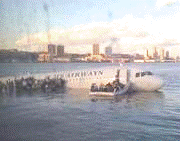Bird Strike Committee Proceedings
Date of this Version
8-2008
Abstract
Opportunities exist to develop airport environments that are unsuitable for wildlife and assist in long-term management of aircraft strike hazards. As part of a multiple year cooperative effort between the University of Illinois Center of Excellence in Airport Technology and the O’Hare Modernization Program, efforts are underway to design a wildlife unfriendly airport. One of the project elements is to consider vegetation selection. Some grasses contain endophytic fungi that produce toxic alkaloids. These alkaloids make the grass less palatable to both birds and mammals. To assess the utility of several grasses for wildlife control, fifteen field plots were established at the University of Illinois. These plots varied five turf grass species on soil types expected at O’Hare airport. Species included endophytic tall fescue and endophytic perennial ryegrass, along with two non-endophytic cool season turf grasses and one non-endophytic warm season grass. Studies were designed to assess the presence of both birds and small mammals on the field plots. Initial results show that Kentucky bluegrass has a higher number of bird visits than either of the endophytic turf grasses. Mixtures of endophytic turf grasses were also used in seeding of graded areas at O’Hare airport in 2007. Studies are also underway to compare wildlife utilization of these sites with other sites on the airport. The overall program uses small experimental plots to develop a better understanding of the effects of vegetation on wildlife and will use large scale plantings at O’Hare airport to assess how small scale experiments can be used to inform turf grass management at airports to discourage wildlife.


Comments
Abstract of poster presentation at Bird Strike Committee USA/Canada Meeting, Lake Mary and Sanford, Florida, August 18–21, 2008.